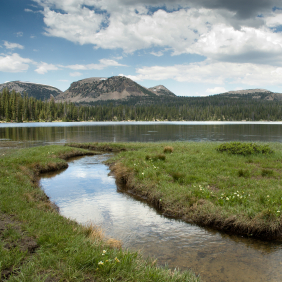
Summer Research Experience for Undergraduates on High Performance Computing and Watershed Modeling
June 17 – July 19, 2013
University of Wyoming, Laramie, Wyoming
The CI-WATER Project, sponsored by the National Science Foundation, is pleased to announce a month instruction and research experience for undergraduates. Preference will be given to residents of Wyoming and Utah or who attend full time one of the universities in either state. The approximately ten participants will form a cohesive group in order to tackle a complex computational science problem that cannot be solved by the individuals in the time period.
High performance computing entails exploiting parallel computing, cache memories, compiled and highly optimized computer programs, and specialized programming techniques for nonobvious implementations of mathematical algorithms.
Participants will learn the C programming language, OpenMP (shared memory multiprocessing) and MPI (message passing for distributed memory multiprocessors), and basic algorithms to solve hydrological problems. The University of Wyoming and the Wyoming NCAR Supercomputer Center have Terascale and Petascale research computing clusters, respectively. We will teach techniques that will be useful on massively parallel computer systems.
Hydrological models constitute a complete watershed analysis system that can be used for a variety of engineering computation and design issues, such as flood control, hydrologic impacts of land use change, and best management practice design and location. The course will feature the spatially distributed modeling components of this system with a combination of lecture and hands on applications.
Participants can optionally attend a one-week mini course in July on the basics of the GSSHA (Gridded Surface Subsurface Hydrologic Analysis) model, developed at the U.S. Army Core of Engineers Engineering Research and Development Center and at the University of Wyoming, and the WMS (Watershed Modeling System), developed at Aquaveo LLC. Attendees will learn to use WMS to parameterize GSSHA models through in-class experience. This course will begin with an overview of the capabilities of the WMS to ensure that the maximum benefit is derived from the hands-on portions of the class. Course attendees will learn the basic spatial data required to parameterize GSSHA distributed models, including data requirements, basics of GSSHA/WMS, and how to find and use spatial geographic data to develop GSSHA models using the WMS Hydrologic Model Wizard. Attendees will also use WMS to develop GSSHA models that include overland flow, infiltration, distributed rainfall, hydraulic structures, continuous simulations with frozen precipitation, and erosion and sediment transport.
The mini course will begin with two days of lectures and hands on use of the software. Day three will be a day for collecting data outdoors in the Laramie general area. Using a rainfall simulator we will be able to generate interesting data to use back in the computer lab on days four and five.
Students from Utah Universities will be hosted at the University of Wyoming at no cost to the student. The stipend will depend upon the student's home university.
Who Should Attend?
Students who want to experience first hand how computational science projects operate. Besides learning the background material to do a project, the participants will be immersed in a very different research type culture that is far different than the usual single student research environment.
The mini course is intended for anyone interested in distributed parameter, physics-based hydrologic models for the purposes of hydrologic and water quality analysis related to flooding, land use change, computing total maximum daily loadings (TMDLs), and/or analyzing best management practices. Experience with hydrologic modeling, numerical methods is not required.
Apply Online
Application Deadline May 24, 2013
(Applications will be reviewed by May 30, 2013)







